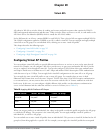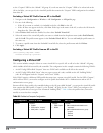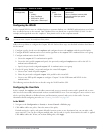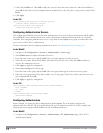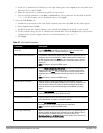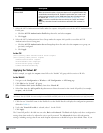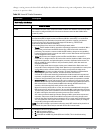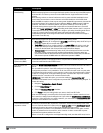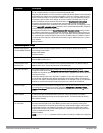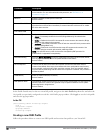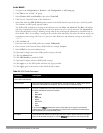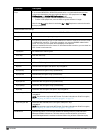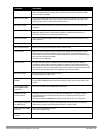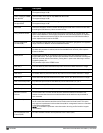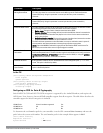
322 | VirtualAPs DellPowerConnectW-SeriesArubaOS6.2 | User Guide
Parameter Description
Band Steering ARM’s band steering feature encourages dual-band capable clients to stay on the 5GHz band on
dual-band APs. This frees up resources on the 2.4GHz band for single band clients like VoIP
phones.
Band steering reduces co-channel interference and increases available bandwidth for dual-
band clients, because there are more channels on the 5GHz band than on the 2.4GHz band.
Dual-band 802.11n-capable clients may see even greater bandwidth improvements, because the
band steering feature will automatically select between 40MHz or 20MHz channels in 802.11n
networks. This feature is disabled by default, and must be enabled in a Virtual AP profile.
The band steering feature supports both campus APs and remote APs that have a virtual AP
profile set to tunnel, split-tunnel or bridge forwarding mode. Note, however, that if a campus or
remote APs has virtual AP profiles configured in bridge or split-tunnel forwarding mode but no
virtual AP in tunnel mode, those APs will gather information about 5G-capable clients
independently and will not exchange this information with other APs that also have bridge or
split-tunnel virtual APs only.
Steering Mode Band steering supports the following three different band steering modes.
l Force-5GHz: When the AP is configured in force-5GHz band steering mode, the AP will try to
force 5Ghz-capable APs to use that radio band.
l Prefer-5GHz (Default): If you configure the AP to use prefer-5GHz band steering mode, the
AP will try to steer the client to 5G band (if the client is 5G capable) but will let the client
connect on the 2.4G band if the client persists in 2.4G association attempts.
l Balance-bands: In this band steering mode, the AP tries to balance the clients across the
two radios in order to best utilize the available 2.4G bandwidth. This feature takes into
account the fact that the 5Ghz band has more channels than the 2.4 Ghz band, and that the
5Ghz channels operate in 40MHz while the 2.5Ghz band operates in 20MHz.
Dynamic Multicast
Optimization (DMO)
Enable/Disable dynamic multicast optimization. This parameter is disabled by default, and
cannot be enabled without the PEFNG license.
Drop Broadcast and
Multicast
Select the Drop Broadcast and Multicast checkbox to filter out broadcast and multicast traffic in
the air.
Do not enable this option for virtual APs configured in bridge forwarding mode. This
configuration parameter is only intended for use for virtual APs in tunnel mode. In tunnel mode,
all packets travel to the controller, so the controller is able to drop all broadcast traffic. When a
virtual AP is configured to use bridge forwarding mode, most data traffic stays local to the AP,
and the controller is not able to filter out that broadcast traffic.
IMPORTANT: If you enable this option, you must also enable the Broadcast-Filter ARP
parameter in the stateful firewall configuration to prevent ARP requests from being dropped. To
enable this setting:
1. Navigate to Configuration > Stateful Firewall.
2. Click the Global Setting tab.
3. Select the Broadcast-Filter ARP checkbox.
4. Click Apply to save your settings before you return to the Virtual AP Profile.
Note also that although a virtual AP profile can be replicated from a master controller to local
Dell controllers, stateful firewall settings do not. If you select the Drop Broadcast and Multicast
option for a Virtual AP Profile on a master controller, you must enable the Broadcast-Filter ARP
setting on each individual local controller.
Convert Broadcast ARP
requests to unicast
If enabled, all broadcast ARP requests are converted to unicast and sent directly to the client.
You can check the status of this option using the show ap active and the show datapath tunnel
command. If enabled, the output will display the letter a in the flags column.
This configuration parameter is only intended for use for virtual APs in tunnel mode. In tunnel
mode, all packets travel to the controller, so the controller is able to convert ARP requests
directed to the broadcast address into unicast.
When a virtual AP is configured to use bridge forwarding mode, most data traffic stays local to




